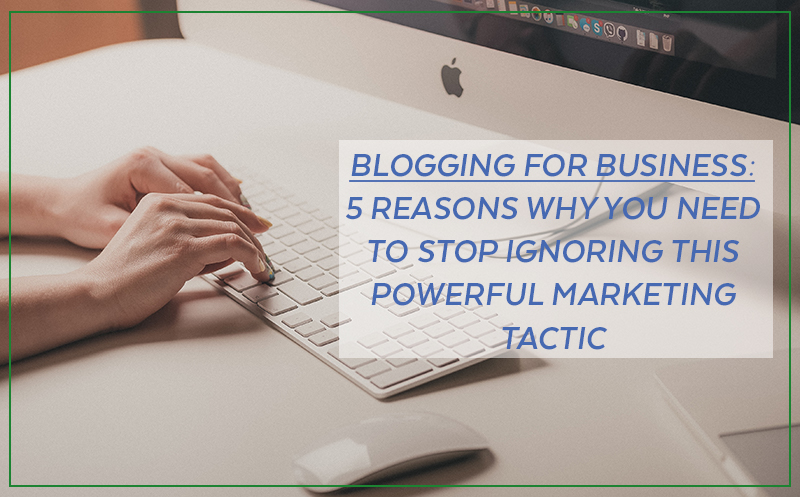Blogging for business – What’s the point?
Let’s be honest, you almost didn’t click through, the words business blog make you screw up your face and go “UGH”. Unless you love writing, the idea of blogging for business sounds like a terrible chore. If you enjoy writing then you probably don’t find the idea quite so repellent but, from experience with business owners, I’d say that at least two or three of these are true:
Whether you love writing or would rather cut off your ear than sit down at your keyboard to bang out 1000 words every week, writing the right blog posts for your business website will attract more clients and increase your revenue.
Blogging for business is a long-term strategy. I’m not suggesting that you can share four or five blog posts and a flood of new customers will be knocking on your door. However, a consistent and sustained effort will lead to exponential growth year on year.
Let me explain why.
You give yourself more opportunities to be found in organic search results.
Publishing relevant, high quality content (aka blogging) on your website regularly means that there are more opportunities for your website to be found when people search online for the answer to a question.
HINT: The best blog content answers a question that your ideal customer might have.
Think about what happens when someone clicks through to your website because you’ve published the answer to a question they have. By providing a great response to that question you’ve gained instant credibility.
There’s a chance they’ll continue to work their way through more of your content, possibly opt in to get updates or a content offer. Eventually you become their go to expert.
But…they’ve never even met or spoken to you.
Blogging helps you to establish authority, without leaving your desk.
Remembering that the whole point of your website is to attract new clients then using your business blog to provide information that will help build your authority and credibility is a smart strategy.
HINT: Better still your product or service might provide the solution to the problem they’re facing that prompted the search in the first place.
A catalogue of blog posts gives you endless potential for social media.
How many times have you spent too long trying to come up with ideas about what to post to social media? Writing one great blog post a week will give you all the content you need for social media.
One blog post is usually a collection of thoughts and ideas pulled together to create a cohesive dialogue. Amongst other things it might be a how-to tutorial or step by step OR an informational piece where you give commentary on a topic you’re expert at.
Once you’ve written a blog post it’s easy enough to break it down into a whole bunch of small chunks. Think about when you’re reading a business book. If it’s a good one there’ll be multiple points on each page that serve as good advice all on their own.
Guess what? Each one of those points is a social media post. A decent blog post should give you about 10-14 individual ideas for social media.
Take each sentence, find an image and add a few words to create a visual that grabs attention. Viola!
Craft your social media post using that single point from your blog post. It doesn’t need to be long, a couple of sentences is fine. Last of all add the link to your original blog post at the end of the post. We recommend using a link shortener like bitly to make it tidier.
Blogging provides more opportunity for growing your email database.
New content gives people a reason to come back to your website. If a visitor didn’t opt in to your email database on their first visit the chances of them opting in grow with each subsequent visit.
If you don’t have a download that you offer to people to opt in that shouldn’t stop you from asking. Instead offer an opportunity to get blog updates delivered direct to their inbox.
HINT: Regardless of whether you have a content upgrade to share, you should offer visitors the opportunity to subscribe for blog updates.
The benefit of having people subscribe for blog updates is two fold. Firstly you’ve got their email address for email marketing. You’re also curating an audience who you know will be interested in reading your blog content when it’s published.
The more people you can get to read each new thing you publish the more likely it will rank higher in organic search results.
New blog content helps you better understand what your clients are looking for.
As business owners we understand what we do and how we help inside and out. This is great for providing a great service to our clients but it can make it harder for us to connect with them.
Let’s say you’re a kinesiologist (I picked this because it’s a profession because I wasn’t sure what it was).
Kinesiology is defined primarily as the use of muscle testing to identify imbalances in the body’s structural, chemical, and emotional energy.
They establish the body’s priority healing needs, and evaluate energy changes brought about by a broad spectrum of therapeutic procedures.
There’s a wide range of issues that a kinesiologist can help with because they offer solutions to many different problems. However, when people are looking for those answers or solutions it’s unlikely that they will be looking for a kinesiologist specifically. They’re more likely to be searching for more information about the problem they’re experiencing.
Regular blogging allows you to address specific problems people are trying to solve.
A blog post does this in more detail than you can with the copy on the main pages of your website. The people who are looking for you have a good understanding of the problem they want solved but often don’t know who can actually help them.
This is true for all professions, not just kinesiologists.
Consider the user intent angle. Think of someone who is interested in selling their business. Who can help with this isn’t immediately obvious. Do they need a broker, a lawyer, an accountant or all of the above? In a scenario like this it’s common for someone to turn to the internet for initial research. For professionals who do help business owners sell, new clients will find them more easily if they have information on the website about how they help.
Using questions in your blog posts (and on social media) will help you understand what people want to know.
As you publish more content and attract more website visitors you’ll get a better understanding of what people are looking for when they find you. This knowledge enables you to refine your offerings and better target your messaging.
Blogging enables you to easily answer buyer questions
Aside from engaging your service or buying your product, the next best thing a visitor can do when they come to your website is to provide you with name and email. This is a signal that they’ve found your website helpful but they want more information from you.
Having a decent catalogue of blog content enables you to easily drip feed more information. Following up an email opt in with a series of emails directing the subscriber to more relevant information will help move them further along their buyer journey. Close towards spending money with you.
Establishing a good understanding of what people are looking for lets you position content to answer follow up questions before the person has even thought to ask. Each new piece of content a prospective client engages with will continue to build your authority.
Blogging for Business – What’s Next?
Like anything, getting started can be the hardest part. Check out this guide to content planning to get you started.
One action you could take directly from what you’ve just read is to sit down and brainstorm a list of all the problems you solve for clients. From there some simple keyword research will help you to rank which topics to tackle first.
If you want a hand, lets chat. Tatum’s been blogging for more than 10 years and understands what’s needed inside and out. She can work with you to develop a content calendar that will attract new clients. Fill in the form below to get started.
[caldera_form id=”CF57552a973c14a”]





